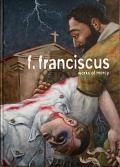Produktbeschreibung
Gut erhaltenes Exemplar. To feed the hungry, to drink the thirsty, to house the strangers, to dress the naked, to nurse the sick, to visit the prisoners, and to bury the dead. It is the age-old known works of mercy. It is not surprising that the artist who named his name after medieval Saint Francis picks up the theme of the seven works. St. Francis is known for his merciful attitude to life, which was evident, among other things, from his help to the lepers. Social problems In his earlier work, Francis regularly referred to art history in often funny ways, now there is more room for current social problems. Examples of works of art with current social issues related to mercy are 'Decoronation - an allegory on violence' (2003) and 'Decapitation (after Gentileschi)' (2005) and 'Friday the thirteenth' (2006). In these paintings, Franciscus refers to the violence against homosexuals and transvestites by young people. In the last canvas in this fictional triptych, Franciscus shows that there is also compassion and mercy. Works of Mercy also shows some biblical scenes about the themes of love, Adam and Eve and the holy family. The final piece takes place in the tower room, where Francis shows a master's exercise in style. Fundamentals Francis is happy to undermine the foundations of art and the art world. Large religious and art-historical themes are masterfully brought to room temperature. Francis regularly takes a painting from the Renaissance or the Dutch seventeenth century as an example. He then interprets the original act in a new tableau vivant of a current theme or event. Examples of painters that St. Francis is indebted to include Bronzino, Gentileschi, Ter Brugghen, Van Baburen and Van Dijck. The work of Franciscus was at the beginning of his career in 1987 related to the painting of the then German-Czech Gruppe Normal. From there, Francis developed his own, unmistakable style.










